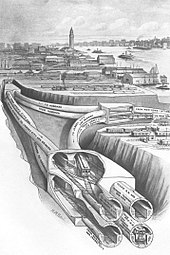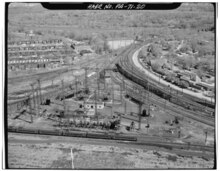Flying junction
A flying junction or flyover is a railway junction at which one or more diverging or converging tracks in a multiple-track route cross other tracks on the route by bridge to avoid conflict with other train movements.
Simple flying junctions may have a single track pass over or under other tracks to avoid conflict; complex flying junctions may have elaborate infrastructure to allow multiple routings without trains coming into conflict, in the manner of a highway stack interchange.
On the French Lignes à Grande Vitesse (TGV) high-speed network, the principal junction on the LGV Sud-Est, at Pasilly where the line to Dijon diverges, and on the LGV Atlantique at Courtalain where the line to Le Mans diverges, are fully grade-separated with special high-speed switches (points in British terminology) that permit the normal line speed of 300 km/h (186 mph) on the main line, and a diverging speed of 220 km/h (137 mph).
[note 1] The LGV network has four grade-separated high-speed triangles: Fretin (near Lille), Coubert (southeast Paris), Claye-Souilly (northeast Paris) and Angles (Avignon).
Finland There are between 25 and about 40 flying junctions on Dutch railways, depending on how more complex examples are counted.






